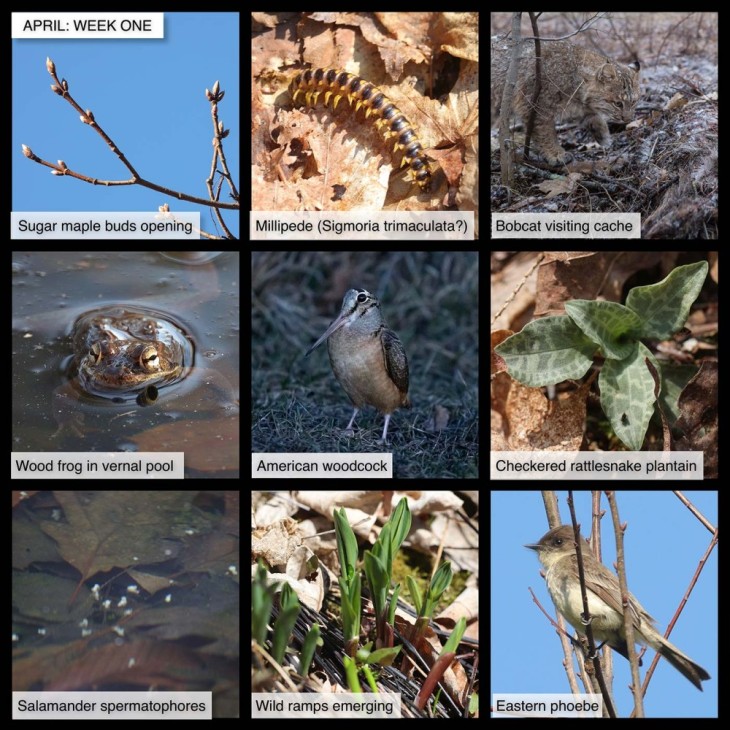This Week in the Woods, sugar maple buds are starting to open in the Upper Valley – a sure sign that sugaring season is coming to an end. Here’s an Outside Story essay by Audrey Clark explaining the many factors that contribute to syrup flavor. And here’s a fun interview with sugarmaker Art Krueger from our Community Voices series. Art, along with his wife Trish Norton, has been producing and selling syrup for over three decades. Teddy the horse helps, too.
We found this millipede, apparently dead, in a fast-running forest stream. Our best guess is it was a Sigmoria trimaculata, as shown in these images at bugguide.net. How do we know it’s a millipede instead of a centipede? For starters, because it has two sets of legs per segment (centipedes have only one set per segment). Although large, waggly-legged arthropods can be hard to love, millipedes are harmless. They feed on plants and detritus, and, unlike centipedes, don’t sting or bite, although some people can suffer skin irritation from handling them. They also have an impressively ancient pedigree. As noted in this article, a 425 million-year-old fossil of a millipede may “represent the oldest-known land animal.”
We continue to obsess over bobcats, and with Tig Tillinghast’s help, had the opportunity to set up another (silent and no flash) remote camera trap at a cache site, where the camera captured feeding activity over several days by two cats. When bobcats aren’t able to consume their whole prey, they will scrape up grass, leaves, and other surrounding materials to obscure the carcass and return again later to feed. Here’s a (previously shared) post from Mary Holland’s Naturally Curious website showing a bobcat cache in winter, and here’s a recent Outside Story essay by Susie Spikol, describing spring dispersal of bobcat young. Although, as Spikol notes, last year’s young typically depart in late winter into early spring, there’s variability in individual behavior. We’re pretty sure that one of the two cats that have visited the cache together is a juvenile.
Wood frogs are back in vernal pools, and you can hear the males chuckling (also described as clucking) en masse. Here’s a profile from the Vermont Reptile & Amphibian Atlas, which notes, “Egg masses are softball-sized with 700 or more eggs.”
American woodcocks are also back and performing their aerial courtship displays above fields and meadows. Northern Woodlands’ online archive has a number of articles about woodcocks, including this 2019 Tracking Tips column by Susan Morse, with several close-up images of the birds, and a look at the “knitting needle-sized holes” made as the birds insert their bills into the mud. Remarkably, the top tip of the bill is able to hinge open to seize worms and other prey underground. Other odd anatomical features include protuberant eyes set far back on the head, and ears located below the eyes. See this article from Audubon, explaining that these features allow woodcocks to remain vigilant to predators while they’re feeding.
We found checkered rattlesnake plantain – a wild orchid – growing high in a mixed stand of conifers and hardwoods. According to The North American Orchid Conservation Center, this is typical habitat. While the plant is not listed as rare in our region, this is the first time we’ve found a specimen, although we frequently see its cousin, downy rattlesnake plantain, featured in this previous post.
This week, you may find roughly pyramid-shaped white blobs in a vernal pool, resting on submerged leaves or arrayed along a submerged stick. What you’re probably seeing are salamander spermatophores –mucosal packages of sperm, which males deposit and females collect in their cloaca, resulting in fertilization. Our most recent Outside Story essay, by Susan Shea, focuses on salamander courtship. See also these stunning underwater vernal pool images by Steven David Johnson (which he graciously shared with Northern Woodlands) and this previously shared article by Cheryl Daigle from our Spring 2021 magazine, describing the work by the Vermont Center for Ecostudies and “citizen-scientist” volunteers to monitor vernal pools.
Although the forest floor is still very brown, we’re seeing more plants emerging on south-facing slopes. Wild ramps are starting to rise out of the leaf litter, inspiring thoughts of spring omelets, pesto, and other foraged food recipes. Here’s a Spring 2017 article from our foraging columnist Benjamin Lord, describing the plants’ growth habits (they do best in “rich, well-drained but moist soils”) and warning against destructive over-harvesting. Lord offers a simple and excellent omelet recipe, too.
Eastern phoebes are back, wagging their tails and peeping from the trees. These flycatchers often build their nests under the eaves of houses, and have a talent for siting nests above the most-used door. Here’s a 2017 photo series from Meghan McCarthy McPhaul, showing developments in a nest above her door, and here’s an Outside Story essay by Carolyn Lorié, describing phoebe site fidelity. As Lorié notes, eastern phoebes tend to return to the same nesting area for multiple years, meaning that the little bird perched on a tree in your yard (and hopefully, swooping down to catch pesky flies in mid-air) may be the same bird you saw last year.
Our thanks to The Bailey Charitable Foundation and the Frank and Brinna Sands Foundation for helping to support this series.
In this difficult period, many of us find joy in observing local nature, and many families are seeking outdoor enrichment opportunities for children. Here are nine photographs taken this past week, most within 15 miles of the Northern Woodlands office in Lyme, New Hampshire. We hope you enjoy using this grid as a prompt for your own explorations, or as the basis for a game of family forest tic-tac-toe.
What are you seeing in the woods this week? Share your images with us on Facebook, or submit a special photo for possible inclusion in our monthly online Reader Photo Gallery.


